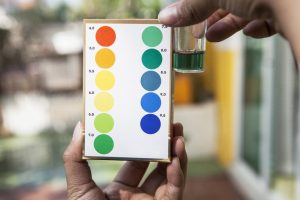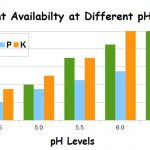I tend to bore people on the subject of soil pH (acidity) and its effects on plant growth but I hope you will read this article and then this article Garden Lime – and see why.
I can tell you that the effect on brassicas is huge. Additional lime, especially dolomite lime with its high levels of magnesium result in crops well beyond what many consider ‘normal’.
 As you may have observed from your gardening experiences plants can be fussy things. The right location, amount of sunlight and 101 other factors influence your plant’s growing ability. One factor which is very beneficial in understanding before putting that new plant into the earth is soil pH.
As you may have observed from your gardening experiences plants can be fussy things. The right location, amount of sunlight and 101 other factors influence your plant’s growing ability. One factor which is very beneficial in understanding before putting that new plant into the earth is soil pH.
What is Soil pH?
Let’s get all scientific for a moment and learn what pH is. In chemistry pH is a measure of how acidic or alkaline a solution is. Okay chemistry lesson over. Basically soil pH is a measure of how acidic or alkaline your soil is. Soil pH is measured on a scale of 1 to 14. If your soil has a pH value of less than 7 then you have acidic soil. On the other hand if your soil has a pH value of greater than 7 then you have alkaline soil. A pH value of 7 is neutral, meaning you have neither acidic or alkaline soil.
The Effect of Soil pH on Plants
Knowing the pH value of your soil before planting is very important as it has a direct influence on the health of the plant. Each plant has its own recommended soil pH value range. The reason for this is that soil pH effects the availability of nutrients within the soil and plants have different nutrient needs.
For example the nutrient nitrogen, a very important plant nutrient, is readily available in soil when the pH value is above 5.5. Similarily the nutrient phosphorous is available when the pH value is between 6 and 7. If a plant is placed into the wrong kind of soil it will be lacking in nutrients that it needs which will promote disease. In general the best pH value range for soil is approximately 6 or 7 as this is the range in which most nutrients can be readily available.
Finding Out pH of Soil
Finding out the pH of soil is usually a trivial matter and the kits to do so should be available at most good garden centres. Usually a pH testing kit will include a small container / test tube, testing solution and a color chart. A sample of soil is taken from your garden, placed into the container / test tube and a few drops of testing solution are added. The container is then shaken and left for a certain period of time. The color of the sample in the container is then compared against the color chart to determine the pH value of the soil.
Note that if you want to determine the soil pH of an large area it may be a good idea to take soil samples from many different locations, combine the samples and then perform the test on the combined sample.
A quick way to find out the pH of an area is to look to see if there are any house hydrangeas (Hydrangea macrophylla) already growing in the area. If so observe the color of its flowers. A soil pH of 6 or below will produce blue flowers while a soil pH of 6.8 or higher will produce pink flowers.
How to Make Soil More Alkaline (Increase pH)
If your soil is acidic or slightly acidic you can take steps to make it more alkaline to accommodate the plants you want to put there. You can make your soil more alkaline (increase its pH value) by adding a form of lime. Lime is a compound of calcium or calcium and magnesium. It is usually applied in the form of ground agricultural limestone, burnt lime or hydrated lime (slaked lime). The smaller the limestone particles then the quicker your soil will become more alkaline. For this reason hydrated lime will offer the quickest performance because it is slightly soluble in water so it can permeate the soil quicker and reduce acidity faster.
Increasing the pH of your soil is not an overnight process and it is best to allow 2-3 months to allow the lime to neutralize the acidity of the soil acidity.
How to Make Soil More Acidic (Decrease pH)
Some ornamental plants and fruit plants like blueberries require an acidic soil. To make your soil more acidic (decrease its pH value) you can use either sulphate of ammonia or sulphur. Sulphate of ammonia is the quickest acting as it will increase the acidity as soon as it dissolves into the soil. The downsides are though that its effects can be short term and it is possible to over-apply it, encouraging too much soft, sappy foliage. Aphid heaven!
Conclusion
Remember to always take into account soil pH when deciding what to plant in your soil. If you do not know what the pH of your soil is then test your soil and if needs be take steps mentioned earlier to change the pH value over time. Best of luck!
This article is by Francis Kilkelly Original article location: Soil pH and its Effect on Your Garden





